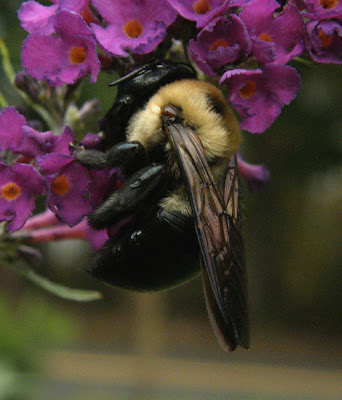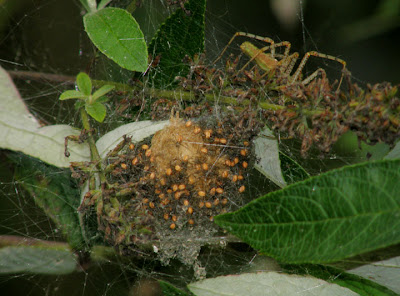 Click on an image to view a larger image
Click on an image to view a larger imageRelated posts:
- Mushroom: Another Amanita sp.
- Mushroom: Amanita sp.
- A Little Rain… Then Mushrooms
 Click on an image to view a larger image
Click on an image to view a larger image The vista
The vista 

 Today, the prominent tree on the point – on the right side in the first and second photos - has lost its leaves but is still photogenic.
Today, the prominent tree on the point – on the right side in the first and second photos - has lost its leaves but is still photogenic.  This photo was taken from the beginning of Segment 2 looking toward the island (Segment 16). The following photos were taken from left to right.
This photo was taken from the beginning of Segment 2 looking toward the island (Segment 16). The following photos were taken from left to right. 
 These trees were on the shore of the lake at the far left-hand side of the first photograph.
These trees were on the shore of the lake at the far left-hand side of the first photograph.  This tree is on the west side of the island.
This tree is on the west side of the island. These trees are on the shoreline behind the island. This photo was taken from in front of the Picnic Area (Segment 15) looking behind the island.
These trees are on the shoreline behind the island. This photo was taken from in front of the Picnic Area (Segment 15) looking behind the island. This tree is on the shore at the west end of the picnic area.
This tree is on the shore at the west end of the picnic area.  During the day, they are feeding on the few remaining wildflowers...
During the day, they are feeding on the few remaining wildflowers... In the evening they settle where they can. This one has taken refuge in one of the last flowers on the butterfly bush.
In the evening they settle where they can. This one has taken refuge in one of the last flowers on the butterfly bush. This is a view of the shoreline above the boat launch (Segment 18) on Marburg Creek reservoir in Fort Yargo State Park.
This is a view of the shoreline above the boat launch (Segment 18) on Marburg Creek reservoir in Fort Yargo State Park.


 The cap on this one was about 12 inches in diameter. This mushroom had been open for some time and discolored from leaves that had fallen on it during recent rainfall.
The cap on this one was about 12 inches in diameter. This mushroom had been open for some time and discolored from leaves that had fallen on it during recent rainfall. This photo was taken on the path that runs along the ledge above the creek. The woods are distinctly chilly although the sun still has a warm bite even this late in the afternoon.
This photo was taken on the path that runs along the ledge above the creek. The woods are distinctly chilly although the sun still has a warm bite even this late in the afternoon. It’s time to harvest firewood for the winter. We harvest only dead trees. Even these sometimes resist leaving the woods. This one hung up on a nearby tree and additional tackle was required to bring it to the ground.
It’s time to harvest firewood for the winter. We harvest only dead trees. Even these sometimes resist leaving the woods. This one hung up on a nearby tree and additional tackle was required to bring it to the ground. This tree will provide firewood for a good portion of winter.
This tree will provide firewood for a good portion of winter. A full profile…
A full profile…  A macro photo…
A macro photo… As it got closer to the time the eggs hatched, she spun more lines to make sure that the egg case was secure. This photo was taken on September 29, 2009.
As it got closer to the time the eggs hatched, she spun more lines to make sure that the egg case was secure. This photo was taken on September 29, 2009. By the time the eggs hatched, the egg case was really secured. In this photo, the instars cluster on the egg case and in the webs around the case, the female is on the branch above and to the right of the case, and the remains of the egg 'shells' hang in the web below the case. This photo was taken on October 4th, 2009.
By the time the eggs hatched, the egg case was really secured. In this photo, the instars cluster on the egg case and in the webs around the case, the female is on the branch above and to the right of the case, and the remains of the egg 'shells' hang in the web below the case. This photo was taken on October 4th, 2009.  A close up of the same egg case with instars. This photo was taken on October 4th, 2009.
A close up of the same egg case with instars. This photo was taken on October 4th, 2009.  Close up of an instar. This photo was taken on October 9th, 2009. I couldn’t find the female this day. The instars appeared to be ‘on their own.’
Close up of an instar. This photo was taken on October 9th, 2009. I couldn’t find the female this day. The instars appeared to be ‘on their own.’

 The water has already dropped about 12 inches from its high point judging by the line of pine needles left by the boat launch when the water receded. It is likely that the deck of the water overflow tower was submerged when the water was at its highest.
The water has already dropped about 12 inches from its high point judging by the line of pine needles left by the boat launch when the water receded. It is likely that the deck of the water overflow tower was submerged when the water was at its highest. Normally the pool looks like this. The water level is even lower in the middle of summer.
Normally the pool looks like this. The water level is even lower in the middle of summer. But after 3 inches of rain, it looks like this.
But after 3 inches of rain, it looks like this.



 This Amanita sp., which I think may be the Rag-veil Amanita (Amanita cineropannosa), fruited in mid to late September.
This Amanita sp., which I think may be the Rag-veil Amanita (Amanita cineropannosa), fruited in mid to late September.